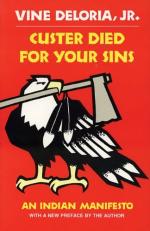
|
| Name: _________________________ | Period: ___________________ |
This test consists of 15 multiple choice questions and 5 short answer questions.
Multiple Choice Questions
1. According to the author, for those whites who do not claim Indian heritage, what asset do they have that connects them with American Indians?
(a) They ARE Indians.
(b) They have friends who are Indians.
(c) They donate to Indian colleges.
(d) They understand Indians.
2. What was the Senate Interior Committee afraid of after the passage of the Wheeler-Howard act?
(a) They were afraid of foreign influences.
(b) They were afraid the French would want the land back.
(c) They were afraid of Indian unity.
(d) They were afraid of the Civil Rights Movement.
3. How does the author believe that America should view the Indian wars of the past?
(a) As Civil Wars.
(b) Not as wars.
(c) As conflicts, not wars.
(d) As the first foreign wars of American history.
4. What is the purpose of the Oklahoma Original Cherokee Community Organization?
(a) Defending marriages on the Cherokee Reservation performed by Native American Ministers.
(b) Defending school financing on the Cherokee Reservation.
(c) Defending water rights for the Cherokee Nation.
(d) Defending hunting and treaty rights of the Cherokee.
5. What kind of people do anthropologists believe the Indians are?
(a) A native people.
(b) A white people.
(c) A folk people.
(d) A foreign people.
6. Once Dillon Myer took over, what was the policy instated from Commissioner to field clerk regarding Indians?
(a) Get them health care as quickly as possible.
(b) Get their land as quickly as possible.
(c) Get rid of them as quickly as possible.
(d) Get them money as quickly as possible.
7. Who appointed Dillon Myer as Commissioner of Indian Affairs?
(a) President Nixon.
(b) President Eisenhower.
(c) President Truman.
(d) President Roosevelt.
8. What have tribes discovered that they must do to make themselves heard?
(a) Band together.
(b) Elect their own congress.
(c) Start a national newspaper.
(d) Elect their own president.
9. What, according to the author, did the white man discover that the American Indians still owned of value?
(a) 135 million acres of land.
(b) Buffalo.
(c) Horses.
(d) Gold.
10. How are the Indians of Canada different from the American Indians?
(a) They live in colder climates and have better housing.
(b) They have not had their basic governmental forms disturbed.
(c) Their medical care is not as good as American Indians.
(d) They are paid by the government NOT to grow crops.
11. What is the main problem for the Plains Indians?
(a) They have no water.
(b) An inadequate land base that continues to shrink because of land sales.
(c) They spend all day making eagle warbonnets.
(d) They still want to go to war.
12. What other name is the Dawes Act known by?
(a) The Indian Ownership Act.
(b) The Allotment Act.
(c) The Peace Act.
(d) The Indian Referral Act.
13. What kind of hats to anthropologists wear?
(a) Australian bush hats.
(b) Indian warbonnets.
(c) Straw hats.
(d) Baseball caps.
14. When does the author believe was the last time that true democracy was alive among Indian tribes?
(a) Pre-Columbian days.
(b) The 1960s.
(c) 1885.
(d) 1756.
15. What year did the Congressional policy of termination begin?
(a) 1934.
(b) 1954.
(c) 1965.
(d) 1880.
Short Answer Questions
1. Like the missionaries, what have anthropologists become intolerably certain of?
2. What, according to the author, is one of the finest things about being an Indian?
3. What are the two mainstream American Indian organizations?
4. When the frontier was closed in 1890, what did American enter into next?
5. What is the oldest, continuous Indian-run organization?
|
This section contains 627 words (approx. 3 pages at 300 words per page) |

|




